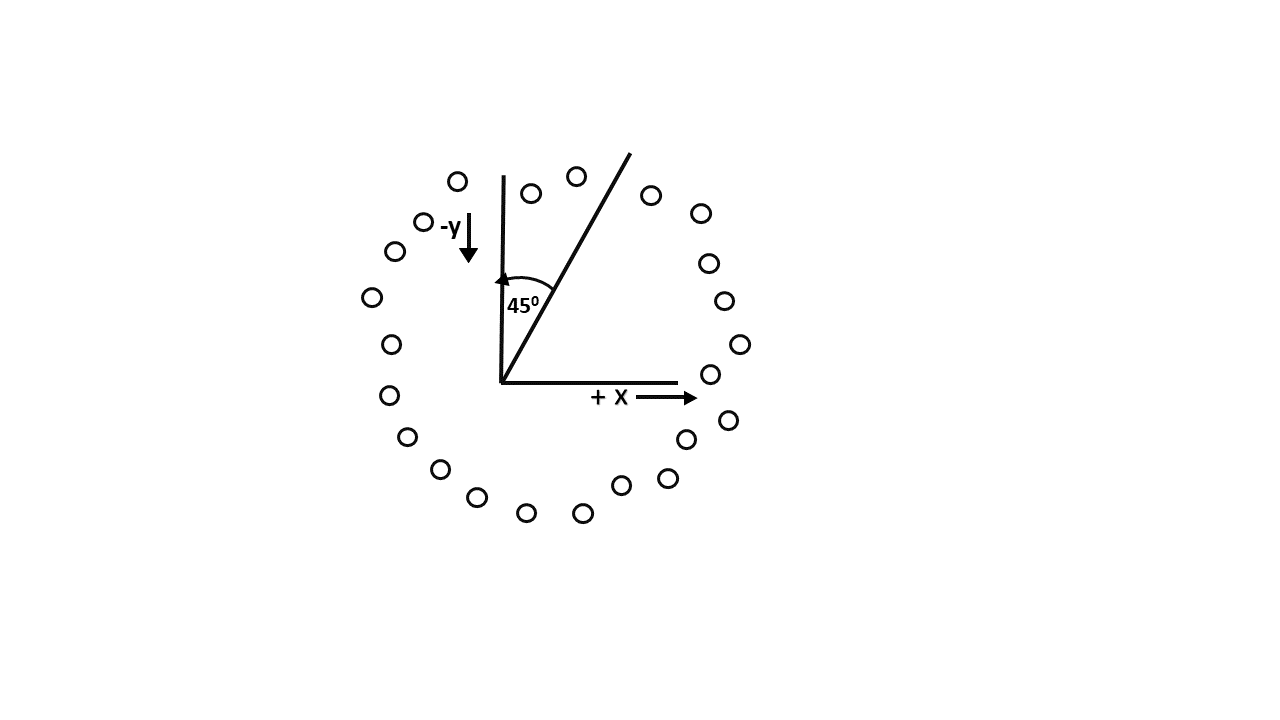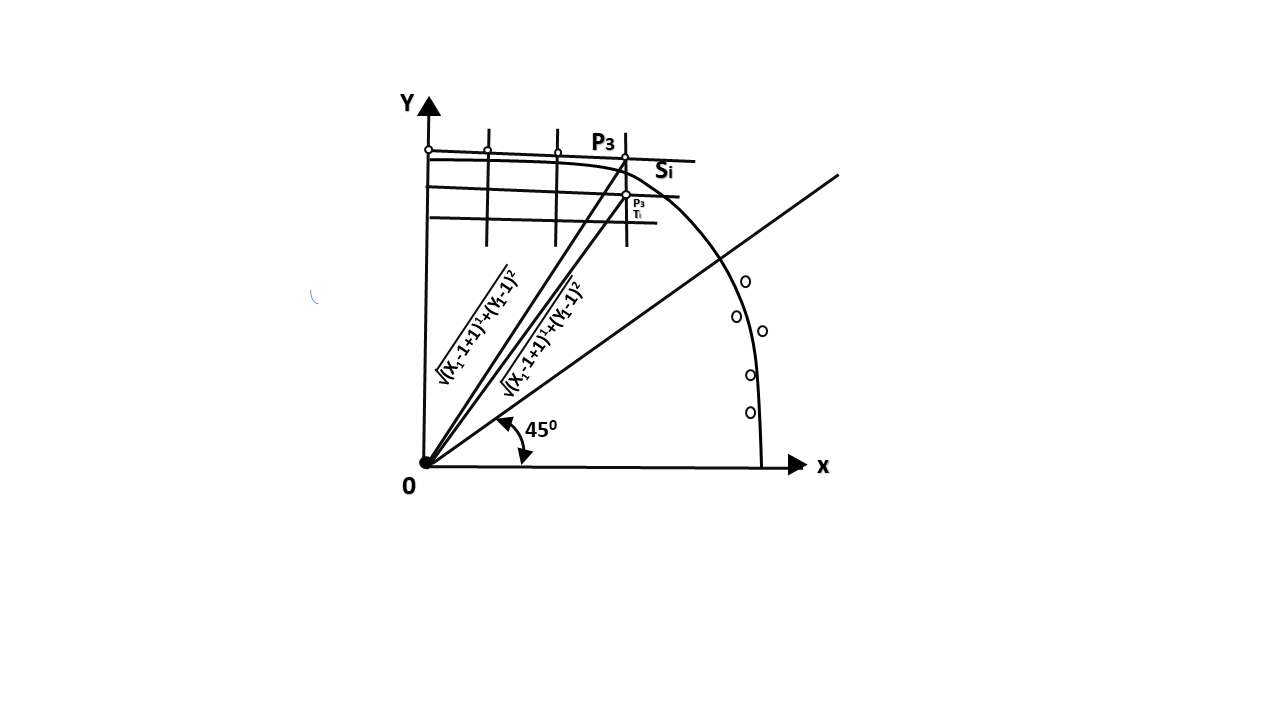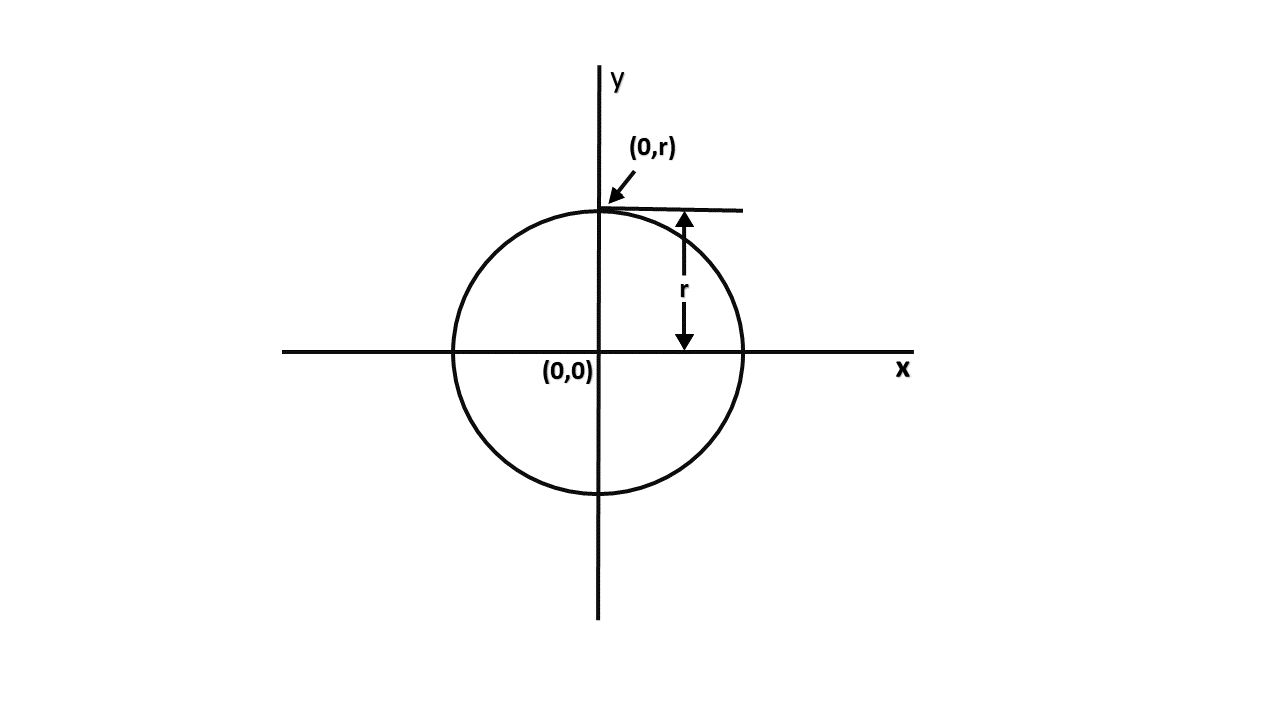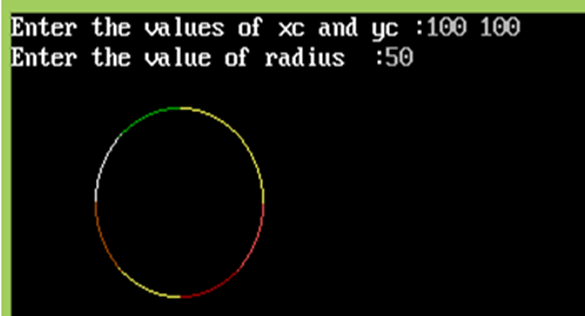使用Bresenham算法对圆进行扫描转换的工作方式如下:点从90°到45°生成, 仅在+ x&-y方向上移动, 如图所示:

真实圆的最佳近似将由栅格中与真实圆的距离最小的那些像素描述。我们想从中产生点

90°至45°。假定最后的经扫描转换的像素是P1, 如图2所示。可以通过以下两个动作之一找到最接近真实圆的每个新点。
- 在x方向上移动一个单位或
- 在x方向上移动一个单位, 在y方向上移动一个负数。
令D(Si)是从原点到真实圆平方的距离减去到点P3平方的距离。 D(Ti)是从原点到真圆平方的距离减去到点P2平方的距离。因此, 出现以下表达式。
D (Si)=(xi-1+1)2+ yi-12 -r2 D (Ti)=(xi-1+1)2+(yi-1 -1)2-r2
由于D(Si)始终为+ ve, 而D(Ti)始终为-ve, 因此可以将决策变量d定义如下:

di = D(硅)+ D(Ti)
Therefore, di=(xi-1+1)2+ yi-12 -r2+(xi-1+1)2+(yi-1 -1)2-r2
从这个方程式, 我们可以将di的初始值驱动为
如果假定圆以原点为中心, 则第一步x = 0&y = r。
因此, di =(0 + 1)2 + r2 -r2 +(0 + 1)2+(r-1)2-r2 = 1 + 1 + r2-2r + 1-r2 = 3-2r
此后, 如果d_i <0, 则仅x递增。
xi+1=xi+1 di+1=di+ 4xi+6
& if di≥0, then x & y are incremented xi+1=xi+1 yi+1 =yi+ 1 di+1=di+ 4 (xi-yi)+10
布雷森汉姆圆算法
步骤1:开始算法
步骤2:声明p, q, x, y, r, d变量p, q是圆心的坐标r是圆心的半径
步骤3:输入r的值
步骤4:计算d = 3-2r
步骤5:初始化x = 0&nbsy = r
步骤6:检查整个圆是否已扫描转换如果x> = y停止
步骤7:使用八向对称的概念绘制八个点。中心位于(p, q)。当前有效像素为(x, y)。像素(x + p, y + q)像素(y + p, x + q)像素(-y + p, x + q)像素(-x + p, y + q)像素(-x + p, – y + q)像素(-y + p, -x + q)像素(y + p, -x + q)像素(x + p, -yq)
步骤8:查找要扫描的下一个像素的位置如果d <0, 则d = d + 4x + 6增量x = x + 1如果d≥0, 则d = d + 4(x-y)+ 10增量x = x + 1递减y = y-1
步骤9:前往步骤6
步骤10:停止算法
示例:使用Bresenham算法绘制6个圆点。圆弧半径为10个单位时。圆的中心为(50, 50)。
解决方案:令r = 10(给出)
步骤1:取初始点(0, 10)d = 3-2r d = 2-3 * 10 = -17 d <0 d = d + 4x + 6 = -17 + 4(0)+ 6 = -11
步骤2:绘制(1, 10)d = d + 4x + 6(∵d <0)= -11 + 4(1)+ 6 = -1
步骤3:绘制(2, 10)d = d + 4x + 6(∵d <0)= -1 + 4 x 2 + 6 = 13
第4步:绘制(3, 9)d> 0, 因此x = x + 1, y = y-1 d = d + 4(xy)+ 10(∵d> 0)= 13 + 4(3-9)+ 10 = 13 + 4(-6)+ 10 = 23-24 = -1
步骤5:绘制(4, 9)d = -1 + 4x + 6 = -1 + 4(4)+ 6 = 21
步骤6:绘制(5, 8)d = d + 4(x-y)+ 10(∵d> 0)= 21 + 4(5-8)+ 10 = 21-12 + 10 = 19
所以P1(0, 0)⟹(50, 50)P2(1, 10)⟹(51, 60)P3(2, 10)⟹(52, 60)P4(3, 9)⟹(53, 59)P5 (4, 9)⟹(54, 59)P6(5, 8)⟹(55, 58)
使用Bresenham的圆图绘制算法绘制圆的程序:
#include <graphics.h>
#include <stdlib.h>
#include <stdio.h>
#include <conio.h>
#include <math.h>
void EightWaySymmetricPlot(int xc, int yc, int x, int y)
{
putpixel(x+xc, y+yc, RED);
putpixel(x+xc, -y+yc, YELLOW);
putpixel(-x+xc, -y+yc, GREEN);
putpixel(-x+xc, y+yc, YELLOW);
putpixel(y+xc, x+yc, 12);
putpixel(y+xc, -x+yc, 14);
putpixel(-y+xc, -x+yc, 15);
putpixel(-y+xc, x+yc, 6);
}
void BresenhamCircle(int xc, int yc, int r)
{
int x=0, y=r, d=3-(2*r);
EightWaySymmetricPlot(xc, yc, x, y);
while(x<=y)
{
if(d<=0)
{
d=d+(4*x)+6;
}
else
{
d=d+(4*x)-(4*y)+10;
y=y-1;
}
x=x+1;
EightWaySymmetricPlot(xc, yc, x, y);
}
}
int main(void)
{
/* request auto detection */
int xc, yc, r, gdriver = DETECT, gmode, errorcode;
/* initialize graphics and local variables */
initgraph(&gdriver, &gmode, "C:\\TURBOC3\\BGI");
/* read result of initialization */
errorcode = graphresult();
if (errorcode != grOk) /* an error occurred */
{
printf("Graphics error: %s\n", grapherrormsg(errorcode));
printf("Press any key to halt:");
getch();
exit(1); /* terminate with an error code */
}
printf("Enter the values of xc and yc :");
scanf("%d%d", &xc, &yc);
printf("Enter the value of radius :");
scanf("%d", &r);
BresenhamCircle(xc, yc, r);
getch();
closegraph();
return 0;
}输出:

 srcmini
srcmini
评论前必须登录!
注册